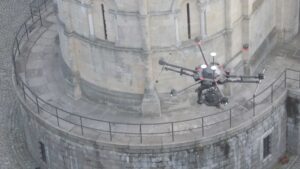Why Building Inspections with Drones Are Reshaping Urban Safety Standards
 In a city like New York, building safety is a serious matter. With thousands of aging structures and millions of people walking its streets, regular façade inspections are essential. But traditional inspection methods—like scaffolding, rope access, and window rigs—come with high costs, long setup times, and safety risks.
In a city like New York, building safety is a serious matter. With thousands of aging structures and millions of people walking its streets, regular façade inspections are essential. But traditional inspection methods—like scaffolding, rope access, and window rigs—come with high costs, long setup times, and safety risks.
That’s why building inspections with drones are quickly becoming a smarter, faster, and safer option. At AeroSpect, we’ve helped lead this shift, especially in dense urban areas where time, access, and public safety are all critical factors.
Why Traditional Methods Fall Short in Urban Areas
Scaffolding and rope access can take days—or even weeks—to set up. These systems block sidewalks, require city permits, and create disruptions for building occupants and pedestrians. They also put workers at risk by placing them dozens of stories above street level. And despite all the effort, coverage is often limited to small sample areas. This means problems might go unnoticed between inspection points.
Drone-based inspections avoid these problems entirely. With no need for scaffolding or rope access, inspections can begin right away. Our drones cover an entire building in just a few hours, collecting high-resolution data without interrupting nearby traffic or foot traffic.
The Role of Building Inspection with Drones in Raising Standards
Drone inspections do more than save time. They improve the quality and consistency of safety documentation. By flying close to the building’s surface, our drones can capture small cracks, corrosion, loose masonry, and other defects in high detail. This makes it easier for engineers, architects, and building managers to detect risks early—before they turn into larger problems.
Because drones can safely reach all areas of a structure, they provide more complete coverage than traditional methods. With full views of the façade, decision-makers have stronger information to use in maintenance planning, safety filings, and repair proposals.
How AeroSpect Helped Change the Rules in NYC
When we started in 2018, drones weren’t allowed to fly in New York City without strict approvals. The laws made inspections harder, slower, and more expensive for everyone involved. Our founders, Edward Kostakis and Pablo Barrera, took action. Working with local officials and industry partners, they helped push for change—and won.
AeroSpect played a direct role in legalizing commercial drone inspections in NYC. This allowed us to offer a faster and safer method to building owners, developers, and Qualified Exterior Wall Inspectors (QEWIs). Today, thanks to those efforts, drone inspections are helping set a new standard for safety in one of the world’s busiest cities.
Regulatory Compliance: Supporting Local Law 11 and Beyond
Under Local Law 11, buildings over six stories must be inspected every five years. QEWIs are responsible for this work, and they must often use scaffolding to perform “hands-on” checks every 60 feet. These drops are expensive and time-consuming.
Drone data helps QEWIs decide where to place drops with more accuracy. Instead of guessing or overcompensating, they can use our high-resolution façade maps to target specific areas of concern. This saves time and reduces unnecessary costs while still meeting all compliance requirements.
AeroSpect’s Technology Advantage
 We use high-resolution cameras, aerial thermography, and 3D modeling to provide more than just photos. Our drones collect detailed visual and structural data from every angle. We also offer LIDAR scanning for more advanced projects.
We use high-resolution cameras, aerial thermography, and 3D modeling to provide more than just photos. Our drones collect detailed visual and structural data from every angle. We also offer LIDAR scanning for more advanced projects.
All inspection results are delivered through the AeroSpect Web Portal—a secure online platform that allows clients to view, annotate, and download their data from anywhere. Our system also supports offline delivery and CAD integration for seamless collaboration with design teams and engineering software.
Our in-house pilots are certified professionals with thousands of hours of flight experience. We also have ITC Level II certified thermographers on staff to support thermal inspections and diagnose moisture or insulation issues.
Shaping the Future of Building Safety
Urban safety standards are changing—and drones are part of the reason why. We’ve already seen how drone technology has helped NYC adapt its inspection processes. As more cities face aging infrastructure and tighter budgets, they’ll need better ways to manage building safety.
Drone inspections offer a clear path forward. They reduce human risk, provide better data, and help professionals make informed decisions faster. With FAA-authorized pilots in New York, Miami, Chicago, Atlanta, and Los Angeles, AeroSpect is ready to help cities nationwide modernize their inspection programs.
Want to Raise the Bar on Safety? Let’s Talk.
If you manage buildings, conduct inspections, or work in compliance, drone inspections can give you a better way to meet your goals. At AeroSpect, we’ve helped clients across the country upgrade their inspection workflows with simple, scalable solutions.
Reach out today to schedule a demo or consultation. You can contact us at info@aerospectny.com or call 718-551-3363 to get started. We’re here to help you take your building safety process to the next level.
